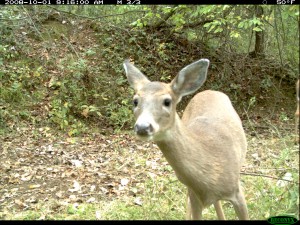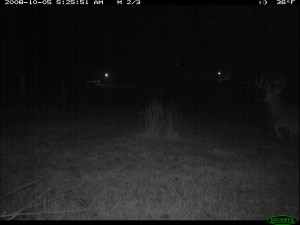Do Trail Cameras Spook Deer
Erich Long – Wild fauna Trends
They say a picture is worth a thousand words and, if yous expect at a deer cam photo long plenty, you lot can come up up with at least a couple of things to say about it. For case, your typical deer cam photo of a cadet tin tell you roughly how one-time it is, a rough score of the animate being and what he is doing at the time the picture was taken. Other than that, a photo falls brusk from helping a deer manager proceeds equally much cognition equally possible.
Trail cameras are excellent direction tools, but their apply always left me asking, "Why?" Why was the creature there to begin with? Why was the animal looking at the camera in some cases? That leads us to this article, "Are nosotros spooking our deer unintentionally?"
1 twenty-four hours I set my new camera over a water pigsty. What I didn't realize at the time, out of stupidity, was I set information technology up on video mode instead of picture mode. Afterwards a few weeks, like near people, I couldn't look to see who showed up. I pulled my card from the camera and rushed straight domicile. As I sat in front of the computer, this strange icon popped upwards. My estimator screen was not filled with the normal icon that goes with trail camera photos. Instead, the screen was full of video clips. I thought to myself, you dummy, what did you do wrong? I clicked on one video clip and to my surprise I admittedly loved what I was seeing. Every bit I watched all the video clips, I speedily became fond of what I was seeing. From that day forwards I vowed to never take another picture with a trail camera again. I would always utilize the video way instead.
My error opened upward a new world of trail photographic camera use. Not only could I age the bucks on the hoof much better, I could come up with a more accurate rough score of the animate being and discover the deer's behavior. My favorite aspect of video mode was that I could encounter what was going on around the animal. Video mode allows deer managers to find not only the beliefs of the animal that triggered the camera, but also the other deer around it. Video mode had taken a valuable inquiry tool, the trail camera, and made information technology even more useful for myself as a deer manager. Information technology answered most if not all those questions of "why" that I had.
Equally the weeks and months went by using my new approach at researching, I was starting to notice something that was out of the ordinary. I was getting a lot of footage of deer that were non too fond of the photographic camera. I didn't call up too much of it at the time considering in the past I would get random pictures of deer looking at the photographic camera. As my video library continued to grow, more and more than deer were looking at the camera at some point during the video clip. When utilizing trail cameras in motion picture style, you are merely seeing i moment in fourth dimension. The deer might not be looking at the camera during that moment, just chances are they were looking at information technology either before or afterward the photo was taken. In video mode, y'all can see a substantially longer timeframe; thus the larger number of observations of deer looking at the camera. After using my trail cameras in video mode for a year, I had a large library of clips of deer looking directly at the photographic camera. It led me to begin questioning what kind of an upshot this was having on their overall beliefs. This could not only affect my research during ratio surveys and looking at age construction, but as well take dramatic effects on my hunting. I decided to dedicate the following year to seeing if deer cameras were having a negative outcome on deer behavior.

I started the twelvemonth with a plan. I was going to set up the cameras in the locations that nigh deer hunters do; food plots, transition zones, scrapes, bedding areas, and feeders, which are legal in the state of Ohio. What we learned from this was amazing to say the to the lowest degree. We learned that less than half of the deer were having a negative reaction to the camera at some betoken during the video clip.
Transition zones from bedding areas to feeding areas were studied first. We fix up the cameras right on a deer trail to come across how they would react. In this location, more than half of the deer would react in a negative fashion. They would walk toward the camera and notice it by sight first, and then in some cases walk up to the camera and odor it. After a month of results, we and then put the photographic camera off the deer run by several yards in an attempt to proceed the photographic camera out of sight. What we found was there was little to no difference in the reaction no matter how close the camera was placed to the deer run. One time again, more than one-half of the deer responded in a negative way.
Bedding areas were the adjacent on the list of areas to test. The results from this area were much like what nosotros observed in transition zones. Nearly half of the deer would respond in a negative way. From the video clips we had gathered so far, themost noticeable aspect of the negative reactions was the difference betwixt sexes. Does and bucks had a night and twenty-four hours difference no thing where we put the cameras. Does would notice the camera and either investigate it by looking at it or effort to get a hint of odor from it. They would also practice the typical head bob and/or stomp we've all seen while hunting. Does would consummate their negative reaction by walking out of the photographic camera's view. When a cadet had a negative reaction to the camera, they would startle just similar a doe. After noticing it, they would investigate information technology and try to scent it. In well-nigh cases, they would get a whiff of scent and reacted as if you smacked them in the butt with a 2×4 and bolted from the surface area.


Our next location was scrapes. The ascertainment nosotros gathered here taught us the most during our written report. What we saw is that nosotros were dictating deer beliefs at scrapes past using trail cameras placed at waist height. Even after taking normal smell precautions on ourselves every bit well every bit the cameras, bucks aged 2.5 years and older would visit the scrape and practise their normal thing. But once if they noticed the camera they would turn inside out and bolt. This reaction was not surprising only what was interesting was the fact that subsequently this initial negative reaction, they would never render. Not all bucks reacted in this manner. The results were dependent on the personality of the buck. Some don't mind little boxes on trees and go about their business organization, while others notice the subtle things and vacate the surface area. We will say that this happened enough to open our eyes to the style we go about using trail cameras on scrapes. Most of this would take gone un-noticed had it non been for video fashion.
The location that brought all the observation together and fabricated the calorie-free bulb turn on was food plots. After a g or so clips, we had merely 1 doe act in a negative manner to the photographic camera. Information technology was an older doe and the merely reason she showed any negative response was that she bumped into the photographic camera. So what does this teach u.s.? Well, what nosotros came up with is that our food plots are where we kept our cameras the longest amount of fourth dimension. They were accustomed to this thing that flashed or glowed at them or a hulk that was part of a tree. This location was dissimilar a scrape that appears during belatedly October where we instantly placed a camera. Food plots are there well-nigh year circular and always offer a peachy opportunity for capturing a deer with a trail camera.
The information nosotros gathered over the form of the flavor and input from other hunters helped us create a theory. I asked around to fellow hunters, "What do you think spooks deer while using cameras"? The majority of the people first 
Typically, hunters place their cameras about waist high. This puts the sensor in line with the bulk of the deer'southward body which maximizes its ability to capture pictures or videos of all of the deer that pass by. In our first test, I placed the cameras ten anxiety high just as a starting point for testing. This in an unrealistic top plus a lot to ask of someone due to safety issues. Our 2d examination we gear up a photographic camera at six feet or middle level to encounter the reaction of the deer. This setup was going to exist at a feeder site on my property in Ohio. We had placed a photographic camera at waist height there 3 weeks prior and captured viii different bucks utilizing the surface area. Over the grade of 2 weeks the bucks began to disappear. We and so moved the camera to eye level. Now, we didn't get all eight bucks on video, but near of them were caught on motion picture and out of 600 clips we had one buck look up at the camera and spook. A neat lesson was learned during this final test!
The conclusion of all this was not to disclaim or bash any photographic camera brand or model. I echo, this was non done to brand you think you shouldn't ever use a deer cam again! This theory of "are nosotros spooking our deer" should be looked upon equally a "positive" observation. Our findings from the nutrient plot sites and the dummy set ups lead us to believe that the deer spook because of visual of the photographic camera on the tree, not the flash. Let's put it this fashion, if you walk into an empty house for nigh of 
Don't concentrate on the acme every bit much every bit sight. The meridian was just a test and you shouldn't go out and move your cameras higher without testing this theory for yourself. The deer herd you lot hunt or manage may not care about the placement. Like I said, not all deer had a negative reaction to the cameras but a large enough percentage of them did on my property for me to warrant this attention to it. Anybody tin examination this theory and you should. Will nosotros continue to put our cameras over scrapes, bedding areas, and transition zone? We will just be smarter about information technology is all. There is so much to larn near deer and their behavior towards cameras and what better style than with observation from a deer cam!
For more articles on wild animals direction topics such as food plot, tree planting, predator command, fertilizing and liming, soil tests, supplemental feeding, fish stocking, weed and grass control in timber and ponds, timber thinning, and many others visit Wildlife Trends. They offer bi-monthly issues from wildlife managers and biologists that help you accept the estimate work out of your land management.
Source: http://themanagementadvantage.com/home/trail-cameras-are-we-spooking-deer-unintentionally/
Posted by: bushthisiumok.blogspot.com

0 Response to "Do Trail Cameras Spook Deer"
Post a Comment